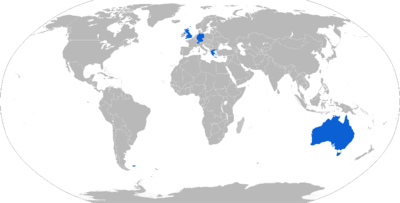SMArt 155

SMArt 155 is a German 155 mm artillery round, designed for a long range, indirect fire top attack role against armoured vehicles. The SMArt carrier shell contains two submunitions, which descend over the battlefield on ballutes and attack hardened targets with explosively formed penetrator warheads. Built with multiple redundant self-destruct mechanisms, these submunitions were specifically designed to fall outside the category of submunition weapons prohibited by the 2008 Convention on Cluster Munitions.
The name SMArt 155 is a contraction of its German name Suchzünder Munition für die Artillerie 155 (meaning "sensor-fuse munition for 155mm artillery"). SMArt is manufactured by GIWS mbh (Gesellschaft für Intelligente WirkSysteme mbH), a partnership between German armaments companies Rheinmetall and Diehl BGT Defence.
SMArt was first deployed by the Bundeswehr in 2000, and has been sold to the armies of Switzerland, Greece, Australia and the United Kingdom.
Design

SMArt 155 is a 155 mm NATO artillery round designed to be fired from the Panzerhaubitze 2000 and the M109 howitzers, including the Paladin variant.[1] It consists of a 47-kilogram (104 lb) heavy artillery projectile containing two autonomous, sensor-fused, fire-and-forget submunitions.[1] The submunitions each contain a high-penetration EFP warhead for use against even heavy armoured armoured fighting vehicles like main battle tanks. The EFP warhead uses a heavy metal liner.[2]
After the submunition is released it opens a parachute. While slowly descending, the submunition rotates, scanning the area below with an infra-red sensor and a millimeter wave radar.[1][2]
The sensor system relying on several types of sensors give SMArt 155 the ability to be used in every type of terrain independent of the weather conditions.[3]
Operation

| Phase | Picture | Description |
|---|---|---|
| 1 |  |
A SMArt-155 round is fired from a standard rifled 155mm artillery tube. |
| 2 | The round flies on a ballistic arc, with a range of 27.5 kilometres (17.1 mi)[4] | |
| 3 | Mid-flight a timer fuse ignites a small ejector rocket in the nose, which drags the two submunitions out of the shell casing. | |
| 4 |  |
Once clear of the shell, the submunitions fall toward the target. The shell and the nose assembly fall away. |
| 5 |  |
The submunitions deploy parachutes, and independently corkscrew down over the subject area, scanning for targets. |
| 6 |  |
Once a submunition detects a target vehicle beneath it, it detonates its explosive payload. This creates a high-velocity explosively formed projectile which strikes the target vehicle from above, where the armour is weak, for maximum effect. |
Competing systems
US artillery largely deploys the M712 Copperhead laser-guided round for the anti-tank role. GIWS formed a partnership with US defence contractor Alliant Techsystems, hoping to sell SMArt 155 to the United States armed forces; to date no sale has been made.[5] The US developed the similar M898 SADARM system (which also descended on a ballute to attack the top surfaces of armoured vehicles), but this was discontinued in favour of the GPS guided M982 Excalibur round.
SMArt 155 is very similar to BAE Systems AB's Bofors 155 Bonus system; BONUS descends on a system of winglets rather than a parachute.
Operators

Current operators
-
 Australian Army[6][7] – replaced M712 Copperhead
Australian Army[6][7] – replaced M712 Copperhead -
 German Army – known as DM702A1, used with the Panzerhaubitze 2000[6]
German Army – known as DM702A1, used with the Panzerhaubitze 2000[6] -
 Hellenic Army – also used in combination with the Panzerhaubitze 2000[6]
Hellenic Army – also used in combination with the Panzerhaubitze 2000[6] -
 Swiss Army[6]
Swiss Army[6]
GIWS and its partners has also demonstrated SMArt to a number of other armies, including those of the United States, the United Arab Emirates[8] (for use in their existing G6 howitzer), Peru, and India. The UK purchase under the IFPA initiative was cancelled.
References
- 1 2 3 "SMArt Sensor-Fuzed Ammunition for 155mm guns". Defense-Update.com. Retrieved 4 December 2010.
- 1 2 "SMArt 155 Family of intelligent munition". GIWS mbh. Retrieved 4 December 2010.
- ↑ "SMArt 155: A new Dimension for Artillery". GIWS mbh. Retrieved 4 December 2010.
- ↑ "SMArt 155". deagel.com. December 30, 2010. Retrieved 7 January 2011.
- ↑ "ATK Partner GIWS Achieves 100-Percent Reliability In Tests of Extended Footprint SMArt 155 Munition Precision-Guided Projectile is Part of ATK's Newly Formed Precision Systems Group". ATK press release. May 9, 2002.
- 1 2 3 4 "SMArt 155 mm Munition für Australien" (in German). Behörden Spiegel Online. Retrieved 2 December 2010.
- ↑ "DEFENCE PURCHASES NEW ANTI-TANK ARTILLERY ROUND". Australian Department of Defence. Retrieved 9 December 2010.
- ↑ http://www.janes.com/articles/Janes-Missiles-And-Rockets-2005/SMArt-155-demonstrated-in-UAE.html
External links
| Wikimedia Commons has media related to SMArt 155. |
- Intelligent ammunition on Diehl's website
- Artillery rounds on Rheimetall-DeTec.de